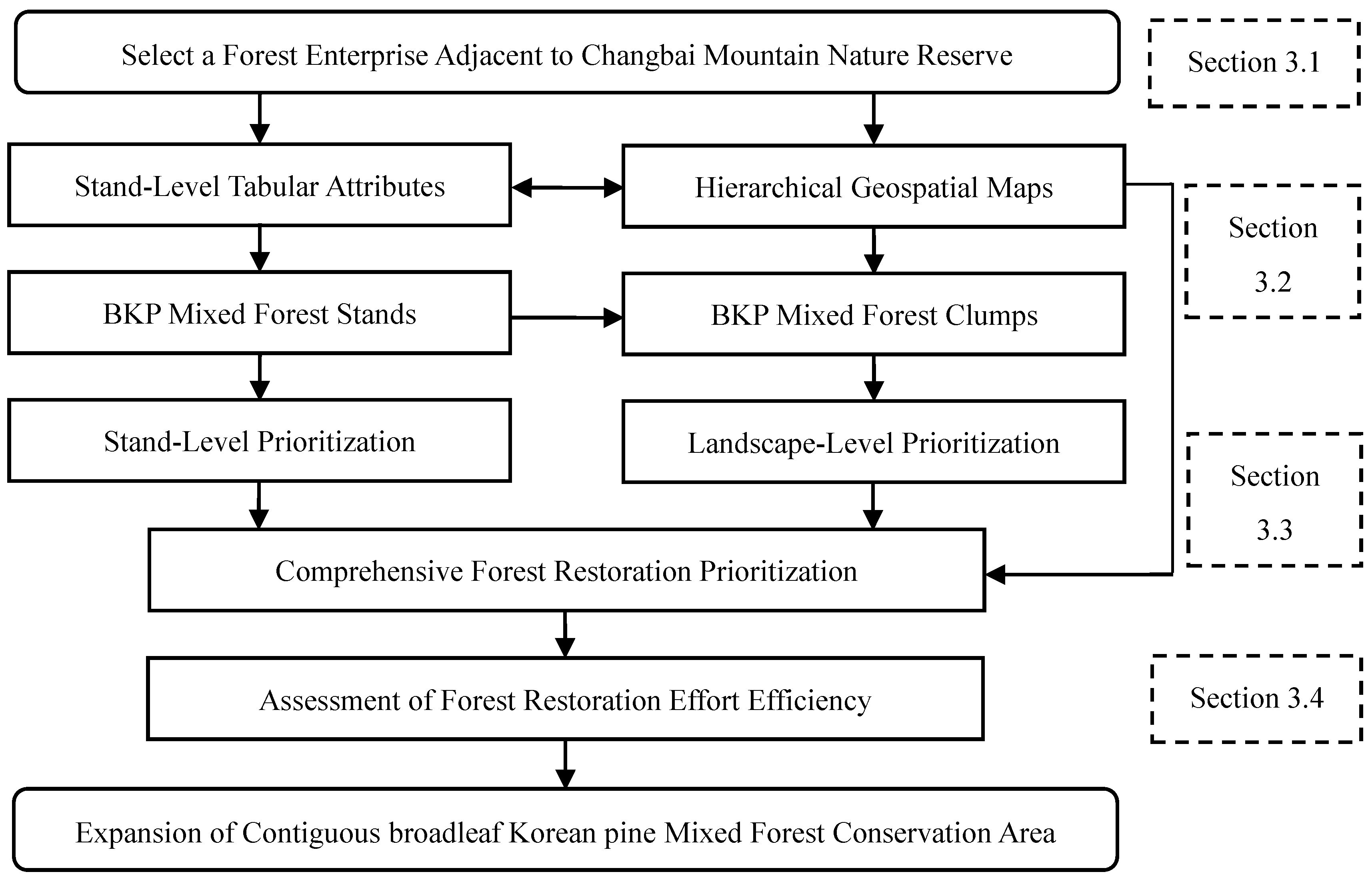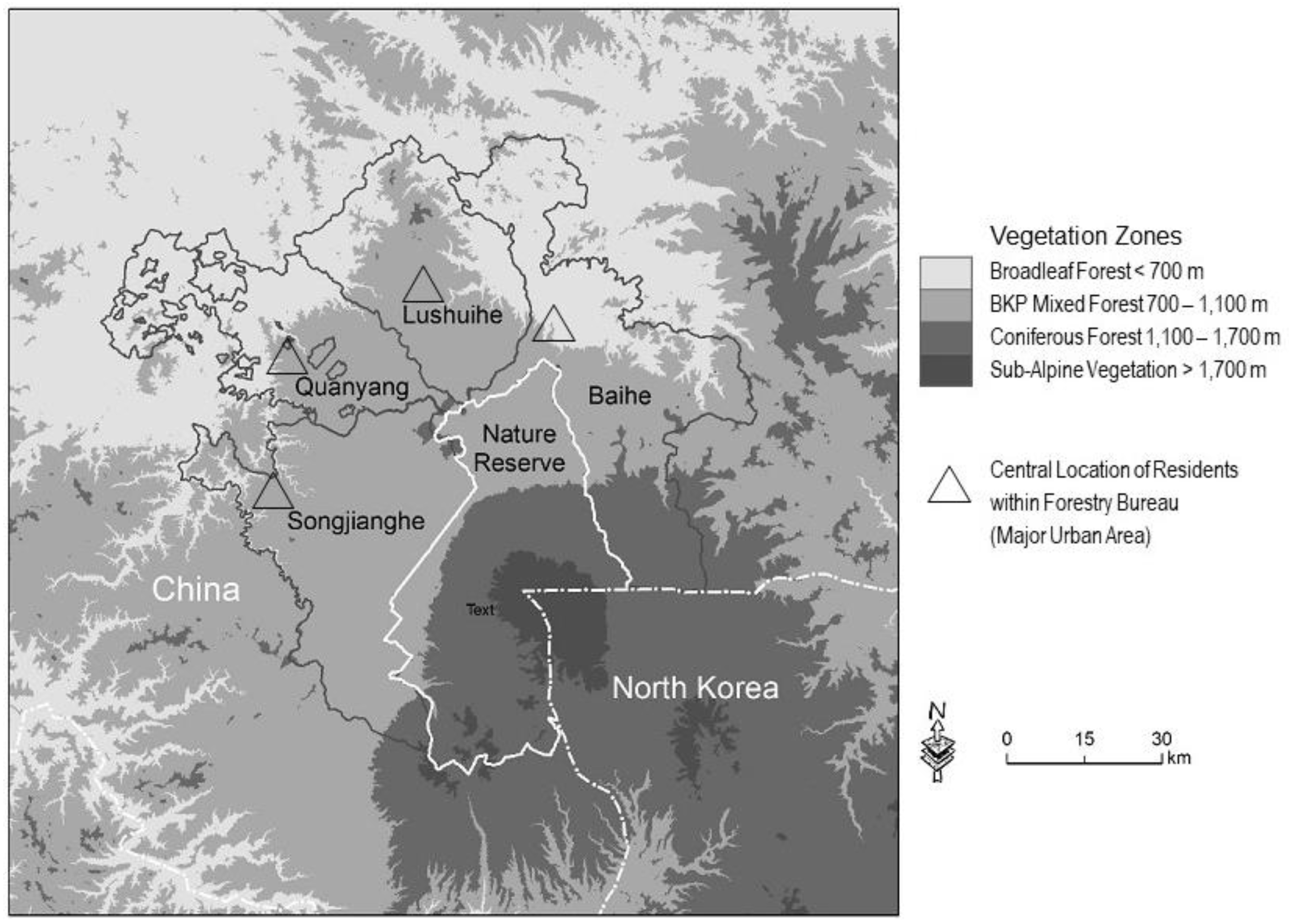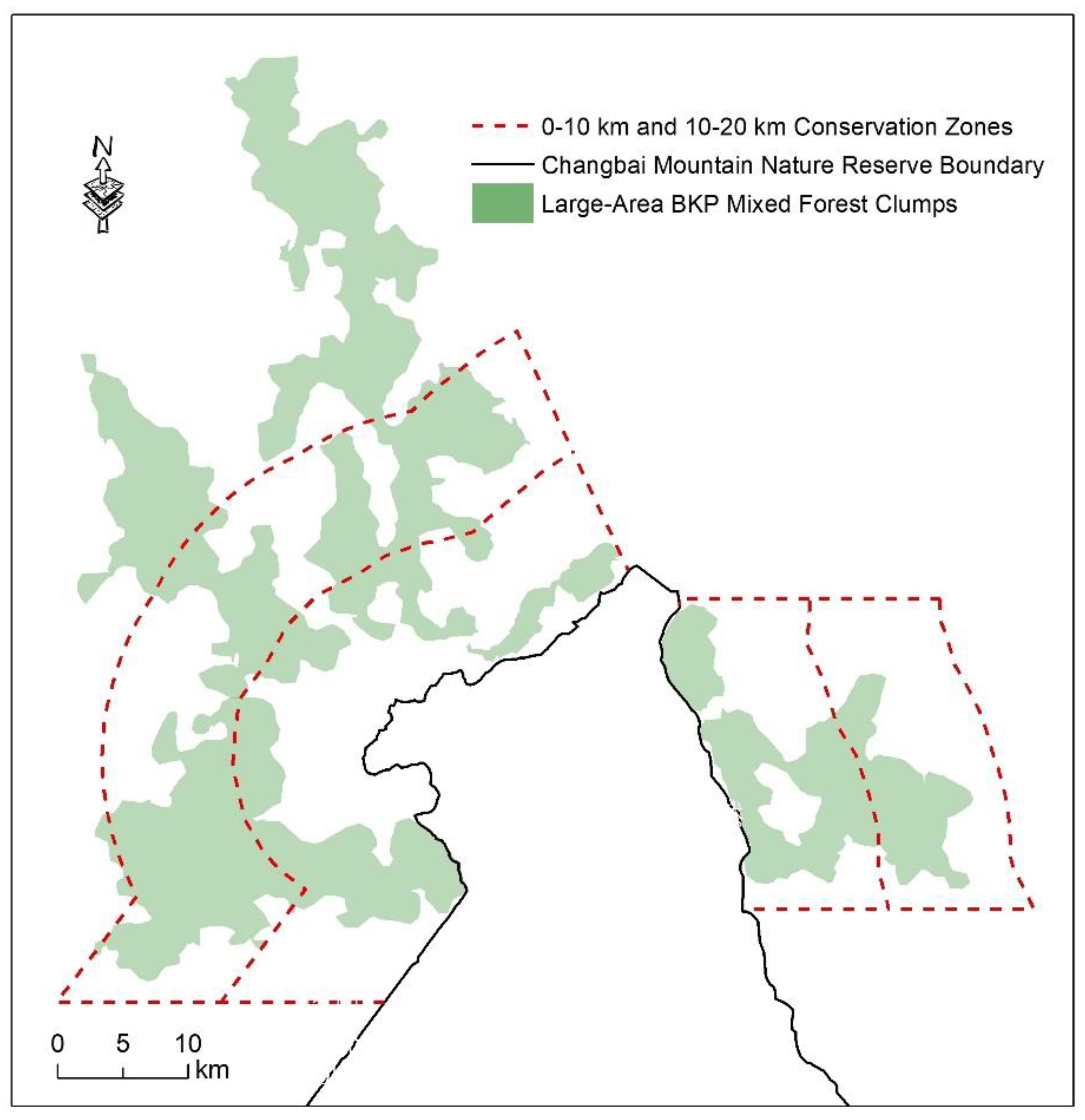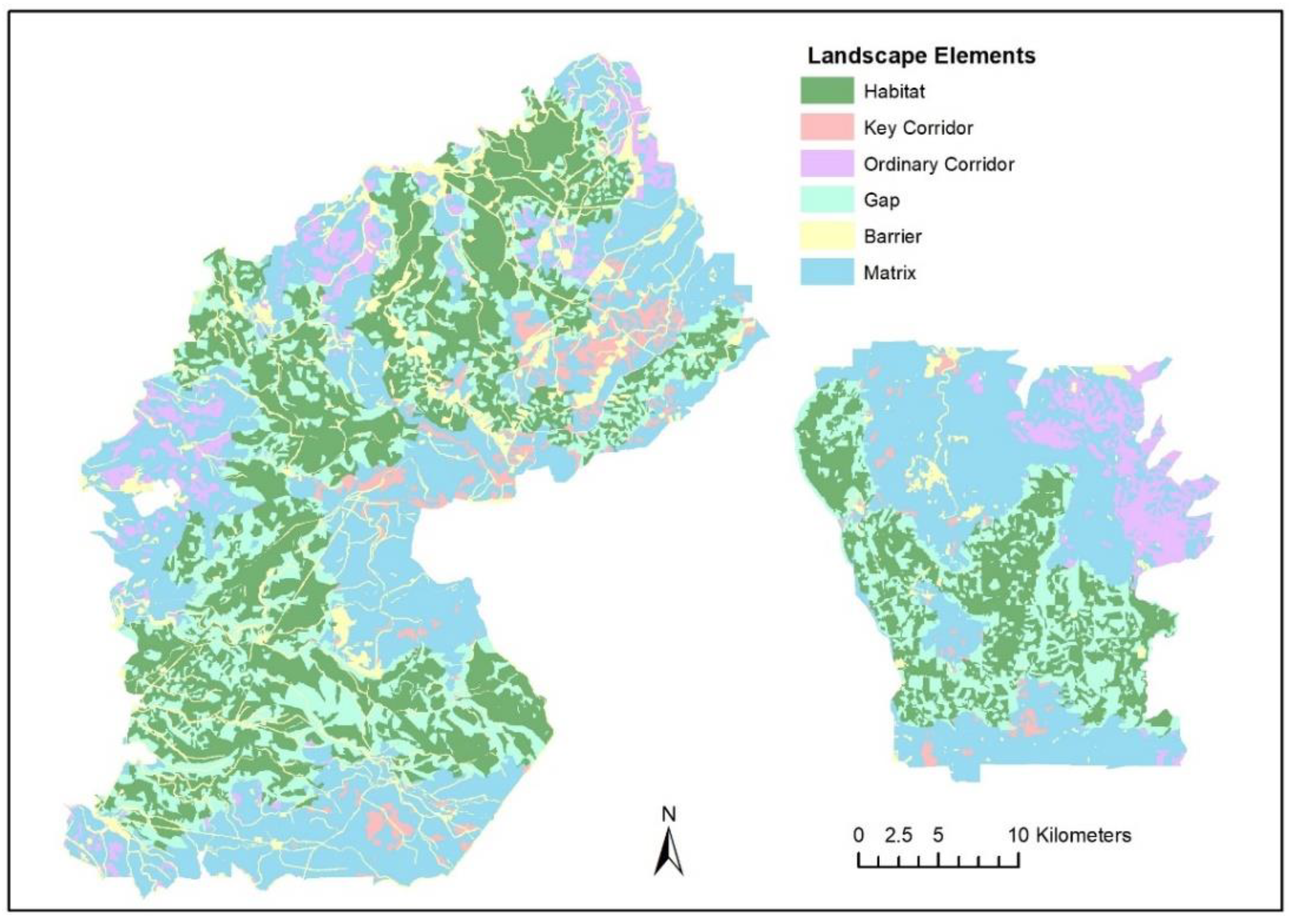A Landscape-Scale Adjoining Conservation (LAC) Approach for Efficient Habitat Expansion: The Case of Changbai Mountain, Northeast China
Abstract
1. Introduction
2. Conservation on Changbai Mountain
3. Materials and Methods
3.1. Site Selection
3.2. Defining Habitat Clumps
3.3. Classifying Landscape Elements
- Type 1:
- Contiguous habitat (habitat), including BKP mixed forests located inside BKP mixed forest clumps;
- Type 2:
- Key BKP mixed forest corridor (key corridor), including BKP mixed forests outside BKP clumps in the key conservation zone;
- Type 3:
- Ordinary BKP mixed forest corridor (ordinary corridor), including BKP mixed forests outside BKP clumps inside the ordinary conservation zone;
- Type 4:
- Habitat gap (gap), including naturally regenerated forests other than BKP mixed forests inside BKP clumps;
- Type 5:
- Habitat barrier (barrier), including man-made non-forest elements;
- Type 6:
- Matrix, which includes all types of forests other than BKP mixed forests outside BKP clumps.
3.4. Assessing the Effectiveness of Landscape Restoration
4. Results
5. Discussion
Author Contributions
Funding
Acknowledgments
Conflicts of Interest
References
- Fried, E. Habitat protection—The key for wildlife management. Conservationist 1983, 37, 10–13. [Google Scholar]
- Hansson, L.; Angelstam, P. Landscape ecology as a theoretical basis of nature conservation. Landsc. Ecol 1991, 5, 191–201. [Google Scholar] [CrossRef]
- Franklin, J.F. Preserving biodiversity: Species, ecosystems, or landscapes? Ecol. Appl. 1993, 3, 202–205. [Google Scholar] [CrossRef] [PubMed]
- Andrén, H. Effects of habitat fragmentation on birds and mammals in landscapes with different proportions of suitable habitat: A review. Oikos 1994, 71, 355–366. [Google Scholar]
- Saura, S.; Bertzky, B.; Bastin, L.; Battistella, L.; Mandrici, A.; Dubois, G. Protected area connectivity: Shortfalls in global targets and country-level priorities. Biol. Conserv. 2018, 219, 53–67. [Google Scholar] [CrossRef] [PubMed]
- Bennett, A.F. Habitat corridors and the conservation of small mammals in a fragmented forest environment. Landsc. Ecol. 1990, 4, 109–122. [Google Scholar] [CrossRef]
- Fahrig, L. Relative effects of habitat loss and fragmentation on population extinction. J. Wildl. Manag. 1997, 61, 604–610. [Google Scholar] [CrossRef]
- Fardila, D.; Kelly, L.T.; Moore, J.L.; McCarthy, M.A. A systematic review reveals changes in where and how we have studied habitat loss and fragmentation over 20 years. Biol. Conserv. 2017, 212, 130–138. [Google Scholar] [CrossRef]
- Hoekstra, J.M.; Boucher, T.M.; Ricketts, T.H.; Roberts, C. Confronting a biome crisis: Global disparities of habitat loss and protection. Ecol. Lett. 2005, 8, 23–29. [Google Scholar] [CrossRef]
- Fischer, J.; Lindenmayer, D.B. Landscape modification and habitat fragmentation: A synthesis. Glob. Ecol. Biogeogr. 2007, 16, 265–280. [Google Scholar] [CrossRef]
- Pouzols, F.M.; Toivonen, T.; Di Minin, E.; Kukkala, A.S.; Kullberg, P.; Kuusterä, J.; Lehtomäki, J.; Tenkanen, H.; Verburg, P.H.; Moilanen, A. Global protected area expansion is compromised by projected land–use and parochialism. Nature 2014, 516, 383–386. [Google Scholar] [CrossRef] [PubMed]
- Sandwith, T.; Shine, C.; Hamilton, L.; Sheppard, D. Transboundary Protected Areas for Peace and Co-operation; IUCN: Gland, Switzerland; Cambridge, UK, 2001. [Google Scholar]
- Lysenko, I.; Besancon, C.; Savy, C. Global List of Transboundary Protected Areas. Available online: http://www.unep-wcmc.org (accessed on 20 June 2018).
- Schoon, M.L. Do Parks Harm More Than They Help? The Role of Peace Parks in Improving Robustness in Southern Africa. Available online: https://www.researchgate.net/profile/Michael_Schoon/publication/237598487_DO_PARKS_HARM_MORE_THAN_THEY_HELP_-_THE_ROLE_OF_PEACE_PARKS_IN_IMPROVING_ROBUSTNESS_IN_SOUTHERN_AFRICA/links/0deec533ae962d5f9a000000/DO-PARKS-HARM-MORE-THAN-THEY-HELP-THE-ROLE-OF-PEACE-PARKS-IN-IMPROVING-ROBUSTNESS-IN-SOUTHERN-AFRICA.pdf (accessed on 18 May 2018).
- Kark, S.; Tulloch, A.; Gordon, A.; Mazor, T.; Bunnefeld, N.; Levin, N. Cross-boundary collaboration: Key to the conservation puzzle. Curr. Opin. Environ. Sustain. 2015, 12, 12–24. [Google Scholar] [CrossRef]
- Shao, G.F. Long-term field studies of old-growth forests on Changbai Mountain in Northeast China. Ann. For. Sci. 2011, 68, 885–887. [Google Scholar] [CrossRef]
- Jia, X.; Ma, F.F.; Zhou, W.M.; Zhou, L.; Yu, D.P.; Dai, L.M. Impacts of climate change on the potential geographical distribution of broadleaved Korean pine (Pinus koraiensis) forests. Acta Ecol. Sin. 2017, 37, 464–473. (In Chinese) [Google Scholar]
- Jeffers, J.N.R. The importance of research in temperate forests. In The Temperate Forest Ecosystem. Proceedings of the International Symposium: Temperate Forest Ecosystem Management and Environment Protection, Jilin, China, 5–11 July 1986; pp. 9–11. [Google Scholar]
- Barnes, B.V.; Xu, Z.B.; Zhao, S.D. Forest ecosystems in an old-growth pine-mixed hardwood forest of the Changbai Shan preserve in northeastern China. Can. J. For. Res. 1992, 22, 144–160. [Google Scholar] [CrossRef]
- Shao, G.F.; Zhao, G.; Zhao, S.D.; Shugart, H.H.; Wang, S.X.; Schaller, J. Forest cover types derived from Landsat TM imagery for Changbai Mountain Area of China. Can. J. For. Res. 1996, 26, 206–216. [Google Scholar] [CrossRef]
- Zhao, G.; Maclean, A.L.; Shao, G.F. Small-area clearcutting and landscape fragmentation in an old-growth forested area of Northeastern China. In Proceedings of the Society of American Foresters, Travers City, MI, USA, 19–23 September 1998; pp. 219–224. [Google Scholar]
- Tang, L.N.; Shao, G.F.; Piao, Z.J.; Dai, L.M.; Jenkins, M.A.; Wang, S.X.; Wu, G.; Wu, J.G.; Zhao, J.Z. Forest degradation deepens around and within protected areas in East Asia. Biol. Conserv. 2010, 143, 1295–1298. [Google Scholar] [CrossRef]
- Piao, Z.J.; Tang, L.N.; Swihart, R.K.; Wang, S.X. Human–wildlife competition for Korean pine seeds: Vertebrate responses and long-term implications for mixed forests on Changbai Mountain, China. Ann. For. Sci. 2011, 68, 911–919. [Google Scholar] [CrossRef]
- Ma, L.; Qu, Y.; Sun, G.Q.; Wan, J.; Li, J.Q. Exploring conservation options in the broad-Leaved Korean pine mixed forest of the Changbai Mountain region. Mt. Res. Dev. 2015, 35, 171–179. [Google Scholar]
- Li, Z.W.; Wu, J.G.; Kou, X.J.; Tian, Y.; Wang, T.M.; Mou, B.; Ge, J.P. Land use pattern and its dynamic changes in Amur tiger distribution region. Yingyong Shengtai Xuebao 2009, 20, 714–724. (In Chinese) [Google Scholar]
- Piao, Z.J. Temperate forest animals on Changbai Mountain. For. Man 2016, 9, 18–31. (In Chinese) [Google Scholar]
- Tang, L.N.; Li, A.X.; Shao, G.F. Landscape-level forest ecosystem conservation on Changbai Mountain, China and North Korea (DPRK). Mt. Res. Dev. 2011, 31, 169–175. [Google Scholar] [CrossRef]
- Liu, K.; Liang, Y.; He, H.S.; Wang, W.J.; Huang, C.; Zong, S.; Wang, L.; Xiao, J.; Du, H. Long-Term Impacts of China’s New Commercial Harvest Exclusion Policy on Ecosystem Services and Biodiversity in the Temperate Forests of Northeast China. Sustainability 2018, 10, 1071. [Google Scholar] [CrossRef]
- Wang, X.C.; Wang, S.D.; Dai, L.M. Estimating and mapping forest biomass in northeast China using joint forest resources inventory and remote sensing data. J. For. Res. 2018, 29, 797–811. [Google Scholar] [CrossRef]
- Hilty, J.; Lidicker, W.Z., Jr.; Merenlender, A.M. Corridor Ecology. Aust. Ecol. 2006, 32, 357. [Google Scholar]
- Kindlmann, P.; Burel, F. Connectivity measures: A review. Landsc. Ecol. 2008, 23, 879–890. [Google Scholar] [CrossRef]
- Bai, J.W.; Zhao, Y.; Shi, L.Y.; Li, F.R. Assessing forest sustainability trajectory with temporal changes in timber output and ecological reserve: The case of China. J. For. Res. 2018, 29, 171–176. [Google Scholar] [CrossRef]
- Barbosa, J.M.; Asner, G.P. Prioritizing landscapes for restoration based on spatial patterns of ecosystem controls and plant-plant interactions. J. Appl. Ecol. 2017, 54, 1459–1468. [Google Scholar] [CrossRef]
- Acquah, E.; Rollins, R.; Dearden, P.; Murray, G. Concerns and benefits of park-adjacent communities in Northern Ghana: The case of Mole National Park. Int. J. Sustain. Dev. World Ecol. 2017, 24, 316–327. [Google Scholar] [CrossRef]
- Grant, A.S.; Nelson, C.R.; Switalski, T.A.; Rinehart, S.M. Restoration of native plant communities after road decommissioning in the rocky mountains: Effect of seed-mix composition on vegetative establishment. Restor. Ecol. 2015, 19, 160–169. [Google Scholar] [CrossRef]
- Tarvainen, O.; Tolvanen, A. Healing the wounds in the landscape—Reclaiming gravel roads in conservation areas. Environ. Sci. Pollut. Res. 2016, 23, 13732–13744. [Google Scholar] [CrossRef] [PubMed]
- Qi, L.; Wang, J.; Yu, D.P.; Dai, L.M.; Contrereas, M. Responses of regeneration and species coexistence to single-tree selective logging for a temperate mixed forest in eastern Eurasia. Ann. For. Sci. 2016, 73, 449–460. [Google Scholar] [CrossRef]
- Gordon, A.; Simondson, D.; White, M.; Moilanen, A.; Bekessy, S.A. Integrating conservation planning and landuse planning in urban landscapes. Landsc. Urban Plan. 2009, 91, 183–194. [Google Scholar] [CrossRef]
- Dorning, M.A.; Koch, J.; Shoemaker, D.A.; Meentemeyer, R.K. Simulating urbanization scenarios reveals tradeoffs between conservation planning strategies. Landsc. Urban Plan. 2015, 136, 28–39. [Google Scholar] [CrossRef]
- Rappaport, D.I.; Tambosi, L.R.; Metzger, J.P. A landscape triage approach: combining spatial and temporal dynamics to prioritize restoration and conservation. J. Appl. Ecol. 2015, 52, 590–601. [Google Scholar] [CrossRef]
- Norden, B.; Dahlberg, A.; Brandrud, T.E.; Fritz, O.; Ejrnaes, R.; Ovaskainen, O. Effects of ecological continuity on species richness and composition in forests and woodlands: A review. Ecoscience 2014, 21, 34–45. [Google Scholar] [CrossRef]
- Humphrey, J.W.; Watts, K.; Fuentes-Montemayor, E.; Macgregor, N.A.; Peace, A.J.; Park, K.J. What can studies of woodland fragmentation and creation tell us about ecological networks? A literature review and synthesis. Landsc. Ecol. 2015, 30, 21–50. [Google Scholar] [CrossRef]




| Landscape-Level Forest Restoration Priorities | |
|---|---|
| Young and mid-aged habitat gaps adjacent to key corridors | 5 |
| Young and mid-aged habitat gaps adjacent to ordinary corridors | 4 |
| Habitat barriers located in BKP mixed forest clumps | 3 |
| Matrix | 2 |
| Other forests located in BKP mixed forest clumps | 1 |
| Stand-level forest restoration priorities | |
| Barren forestlands | 5 |
| Planted forests | 4 |
| Young and middle-aged/near-mature broadleaf or coniferous forests | 3 |
| Young and middle-aged/near-mature mixed forests | 2 |
| Mature and over-mature forests | 1 |
| Habitat | Key Corridor | Ordinary Corridor | Gap | Barrier | Matrix | ||
|---|---|---|---|---|---|---|---|
| Baihe | Sub-Cpt. Counts | 882 | 120 | 294 | 1251 | 356 | 2350 |
| Total Area (ha) | 13,091 | 1247 | 4729 | 11,696 | 1250 | 25,175 | |
| Mean Area (ha) | 14.8 | 10.4 | 16.1 | 9.3 | 3.5 | 10.7 | |
| Lushuihe | Sub-Cpt. Counts | 777 | 186 | 221 | 442 | 660 | 1116 |
| Total Area (ha) | 13,010 | 2470 | 3003 | 4983 | 2721 | 13,034 | |
| Mean Area (ha) | 16.7 | 13.3 | 13.6 | 11.3 | 4.1 | 11.7 | |
| Quanyang | Sub-Cpt. Counts | 417 | 31 | 145 | 345 | 384 | 926 |
| Total Area (ha) | 7031 | 455 | 2020 | 3715 | 658 | 9951 | |
| Mean Area (ha) | 16.9 | 14.7 | 13.9 | 10.8 | 1.7 | 10.7 | |
| Songjianghe | Sub-Cpt. Counts | 1,026 | 102 | 77 | 1077 | 690 | 2,107 |
| Total Area (ha) | 17,141 | 1464 | 628 | 12,446 | 1540 | 21,478 | |
| Mean Area (ha) | 16.7 | 14.4 | 8.2 | 11.6 | 2.2 | 10.2 | |
| Total | Sub-Cpt. Counts | 3,102 | 439 | 737 | 3115 | 2090 | 6,499 |
| Total Area (ha) | 50,273 | 5636 | 10,380 | 32,840 | 6169 | 69,638 | |
| Mean Area (ha) | 16.2 | 12.8 | 14.1 | 10.5 | 3.0 | 10.7 |
| Entire 20 km Conservation Zone | Sub-Compartments with Highest and Second-Highest Restoration Priority | Percent of Highest and Second-Highest Restoration Targets within 20 km Zone | ||
|---|---|---|---|---|
| Baihe | Sub-cpt. counts | 5253 | 196 | 3.7 |
| Total area (ha) | 57,188 | 1589 | 2.8 | |
| Lushuihe | Sub-cpt. counts | 3402 | 187 | 5.5 |
| Total area (ha) | 39,221 | 1724 | 4.4 | |
| Quanyang | Sub-cpt. counts | 2248 | 122 | 5.4 |
| Total area (ha) | 23,830 | 851 | 3.6 | |
| Songjianghe | Sub-cpt. counts | 5079 | 337 | 6.6 |
| Total area (ha) | 54,697 | 2845 | 5.2 | |
| Total | Sub-cpt. counts | 15,982 | 842 | 5.3 |
| Total area (ha) | 174,936 | 7009 | 4.0 |
| TPRA (ha) | MPAH1 (ha) | MPAH2 (ha) | MPAH Change (%) | RELE | |
|---|---|---|---|---|---|
| Baihe | 1589 | 4905 | 7177 | 46.3 | 1.4 |
| Lushuihe | 1724 | 7876 | 14,642 | 85.9 | 3.9 |
| Quanyang | 851 | 4398 | 5564 | 26.4 | 1.4 |
| Songjianghe | 2845 | 5953 | 13,538 | 127.4 | 2.7 |
| Overall | 7009 | 23,132 | 40,918 | 76.9 | 2.5 |
© 2018 by the authors. Licensee MDPI, Basel, Switzerland. This article is an open access article distributed under the terms and conditions of the Creative Commons Attribution (CC BY) license (http://creativecommons.org/licenses/by/4.0/).
Share and Cite
Bai, J.; Tang, L.; Wang, Q.; Li, F. A Landscape-Scale Adjoining Conservation (LAC) Approach for Efficient Habitat Expansion: The Case of Changbai Mountain, Northeast China. Sustainability 2018, 10, 2919. https://doi.org/10.3390/su10082919
Bai J, Tang L, Wang Q, Li F. A Landscape-Scale Adjoining Conservation (LAC) Approach for Efficient Habitat Expansion: The Case of Changbai Mountain, Northeast China. Sustainability. 2018; 10(8):2919. https://doi.org/10.3390/su10082919
Chicago/Turabian StyleBai, Jianwei, Lina Tang, Qingchun Wang, and Fengri Li. 2018. "A Landscape-Scale Adjoining Conservation (LAC) Approach for Efficient Habitat Expansion: The Case of Changbai Mountain, Northeast China" Sustainability 10, no. 8: 2919. https://doi.org/10.3390/su10082919
APA StyleBai, J., Tang, L., Wang, Q., & Li, F. (2018). A Landscape-Scale Adjoining Conservation (LAC) Approach for Efficient Habitat Expansion: The Case of Changbai Mountain, Northeast China. Sustainability, 10(8), 2919. https://doi.org/10.3390/su10082919






